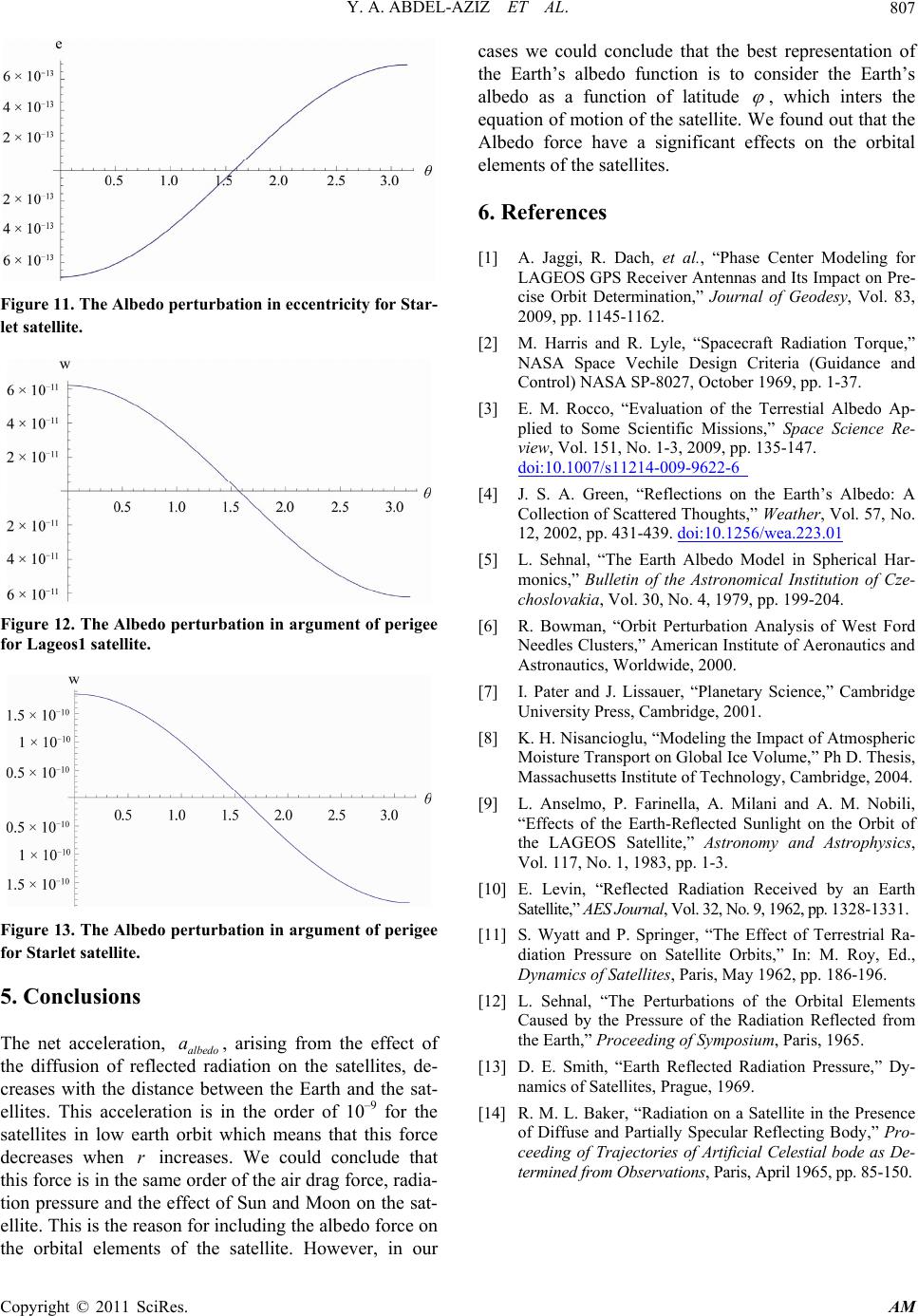
Y. A. ABDEL-AZIZ ET AL.
Copyright © 2011 SciRes. AM
807
Figure 11. The Albedo perturbation in eccentricity for Star-
let satellite.
Figure 12. The Albedo per turbation in argument of perigee
for Lageos1 satellite.
Figure 13. The Albedo per turbation in argument of perigee
for Starlet satellite.
n, , arising from the effect of
radiatio
5. Conclusions
The net acceleratio albedo
a
the diffusion of reflectedn on the satellites, de-
creases with the distance between the Earth and the sat-
ellites. This acceleration is in the order of 10–9 for the
satellites in low earth orbit which means that this force
decreases when r increases. We could conclude that
this force is in the same order of the air drag force, radia-
tion pressure and the effect of Sun and Moon on the sat-
ellite. This is the reason for including the albedo force on
the orbital elements of the satellite. However, in our
cases we could conclude that the best representation of
the Earth’s albedo function is to consider the Earth’s
albedo as a function of latitude
, which inters the
equation of motion of the satellite. We found out that the
Albedo force have a significant effects on the orbital
elements of the satellites.
6. References
[1] A. Jaggi, R. D
LAGEOS GPS
ach, et al.ter Modeling for
Receiver Antenn Its Impact on Pre-
ignia (Guidance and
e Re-
, “Phase Cen
as and
Criter
cise Orbit Determination,” Journal of Geodesy, Vol. 83,
2009, pp. 1145-1162.
[2] M. Harris and R. Lyle, “Spacecraft Radiation Torque,”
NASA Space Vechile Des
Control) NASA SP-8027, October 1969, pp. 1-37.
[3] E. M. Rocco, “Evaluation of the Terrestial Albedo Ap-
plied to Some Scientific Missions,” Space Scienc
view, Vol. 151, No. 1-3, 2009, pp. 135-147.
doi:10.1007/s11214-009-9622-6
[4] J. S. A. Green, “Reflections on the Earth’s
Collection of Scattered Thoughts,”
Albedo: A
Weather, Vol. 57, No.
12, 2002, pp. 431-439. doi:10.1256/wea.223.01
[5] L. Sehnal, “The Earth Albedo Model in Spherical Har-
monics,” Bulletin of the Astronomical Institution of Cze-
utics and
lume,” Ph D. Thesis,
o. 9, 1962, pp. 1328-1331.
m
eflecting Body,” Pro-
choslovakia, Vol. 30, No. 4, 1979, pp. 199-204.
[6] R. Bowman, “Orbit Perturbation Analysis of West Ford
Needles Clusters,” American Institute of Aerona
Astronautics, Worldwide, 2000.
[7] I. Pater and J. Lissauer, “Planetary Science,” Cambridge
University Press, Cambridge, 2001.
[8] K. H. Nisancioglu, “Modeling the Impact of Atmospheric
Moisture Transport on Global Ice Vo
Massachusetts Institute of Technology, Cambridge, 2004.
[9] L. Anselmo, P. Farinella, A. Milani and A. M. Nobili,
“Effects of the Earth-Reflected Sunlight on the Orbit of
the LAGEOS Satellite,” Astronomy and Astrophysics,
Vol. 117, No. 1, 1983, pp. 1-3.
[10] E. Levin, “Reflected Radiation Received by an Earth
Satellite,” AES Journal, Vol. 32, N
[11] S. Wyatt and P. Springer, “The Effect of Terrestrial Ra-
diation Pressure on Satellite Orbits,” In: M. Roy, Ed.,
Dynamics of Satellites, Paris, May 1962, pp. 186-196.
[12] L. Sehnal, “The Perturbations of the Orbital Elements
Caused by the Pressure of the Radiation Reflected fro
the Earth,” Proceeding of Symposium, Paris, 1965.
[13] D. E. Smith, “Earth Reflected Radiation Pressure,” Dy-
namics of Satellites, Prague, 1969.
[14] R. M. L. Baker, “Radiation on a Satellite in the Presence
of Diffuse and Partially Specular R
ceeding of Trajectories of Artificial Celestial bode as De-
termined from Observations, Paris, April 1965, pp. 85-150.